July 27, 2020
The Perseverance Mars Rover is set to launch this week and tasked with the big mission of searching for signs of potential habitable conditions on Mars. Perseverance is undertaking the high-priority science and geology goals presented by NASA to understand if microbial life was once present on the planet.
In order to reach those goals, Perseverance is well-equipped with innovative technologies to ensure a successful launch, surviving the harsh climate of Mars and doing the hard labor of searching for signs of life once it touches down on the planet in early 2021.
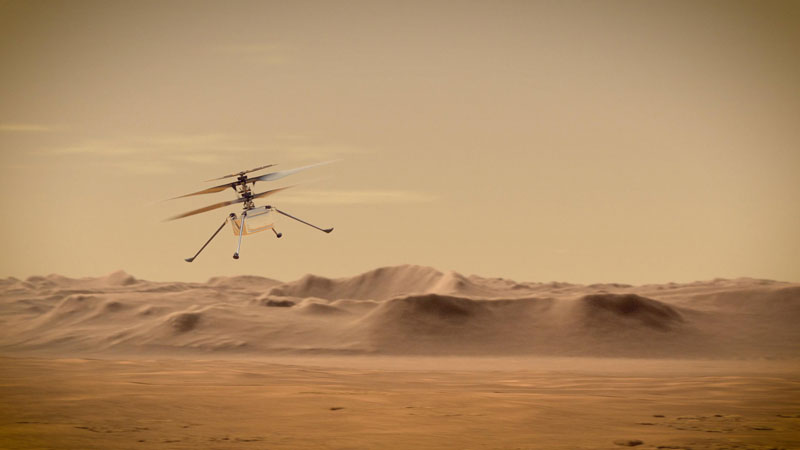
1. It will carry a tiny helicopter
Perseverance isn’t going to Mars without a little help from its friends. “ Bolted to the rover’s undercarriage is a small autonomous helicopter called Ingenuity,” according to an IEEE Spectrum article. “If all goes as planned, it will become the first aircraft to make a powered flight on another planet.”
Flying a drone on Mars is going to be a challenge because of the harsh climate and thin air. A simple wind gust can be problematic because the atmosphere is 1 percent less dense than Earth.
“While the car-size Perseverance has a mass of 1,025 kilograms, the drone is just 1.8 kg with a fuselage the size of a box of tissues,” according to the article. “Ingenuity’s twin carbon-fiber rotors sit on top of one another and spin in opposite directions at about 2,400 rpm, five times as fast as most helicopter rotors on Earth. If they went any slower, the vehicle couldn’t get off the ground. Much faster, and the outer edges of the rotors would approach supersonic speed, possibly causing shock waves and turbulence that would make the drone all but impossible to stabilize.”
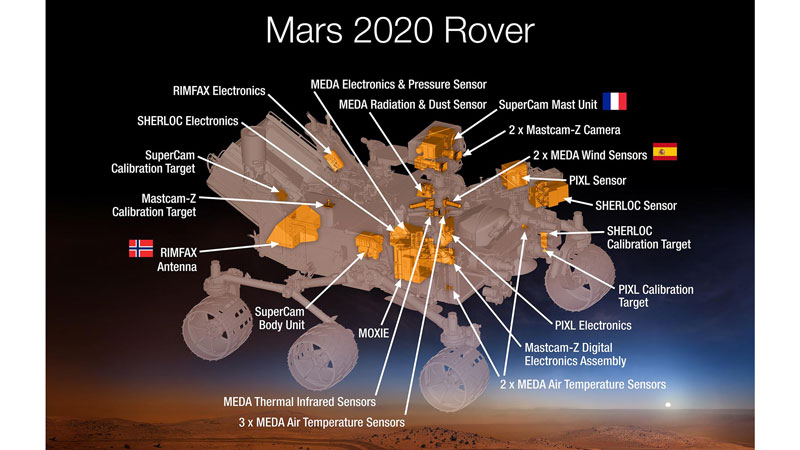
2. It will be autonomous
Not only will Ingenuity be autonomous, but Perseverance will also be capable of understanding the same technologies we use for self-driving cars on Earth.
“Engineers have given Perseverance more self-driving smarts than any other rover, allowing it to cover more ground in a day’s operations without having to wait for engineers on Earth to send up instructions,” according to NASA. “Calculated over the length of the mission, this fast pace can translate into more science. This fast-traverse capability will make exploration of the Moon, Mars and other celestial bodies more efficient for other spacecraft.”
Perseverance’s advanced autonomy is possible because of an array of sensors and machine learning algorithms on two computers to get it through the rockiest of terrains.
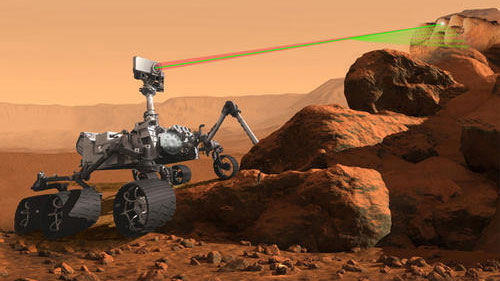
3. Lasers Are Looking for Life
Perseverance is a geologist at heart. In order to search for microbial life, it will be using a SuperCam 1064-nm remote Laser Induced Breakdown Spectroscopy (LIBS) and spectrometer to examine rock and soils.
“From more than 20 feet (~7 meters) away, SuperCam can fire a laser to study rock targets smaller than a pencil point,” according to NASA. “That lets Perseverance study spots it can’t reach with its arm.”
The laser is helpful because it clears dust and helps the technology get clearer views of targets and acquire more accurate data as a result.
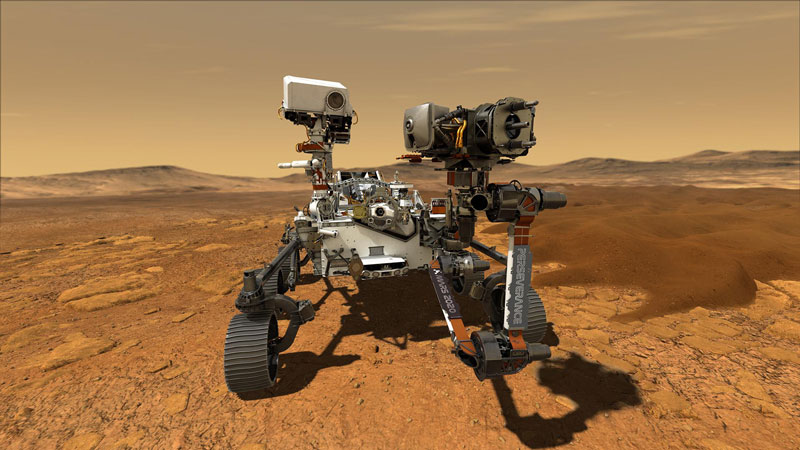
4. It has a turret arm to drill
Another way Perseverance will be gathering samples and data is through its 7-foot-long robotic arm. Much like a human arm with moving joints, Perseverance will be able to handle tools to help “extract cores from rocks, take microscopic images and analyze the elemental composition and mineral makeup of Martian rocks and soil.”
The hand, or “turret”, will be capable of carrying scientific cameras and even has a special sensor to protect the robot from incorrectly contacting the surface to reduce the chance of damage.
5. It will be broadcasted
Perseverance is bringing Mars to you. The spacecraft and robot will feature 23 cameras, which is more than any interplanetary mission in history has ever carried. Once Perseverance drops down on Mars in early 2021, the cameras will help engineers and researchers understand the landscape of an unknown world. Raw and processed images available on the mission’s website.
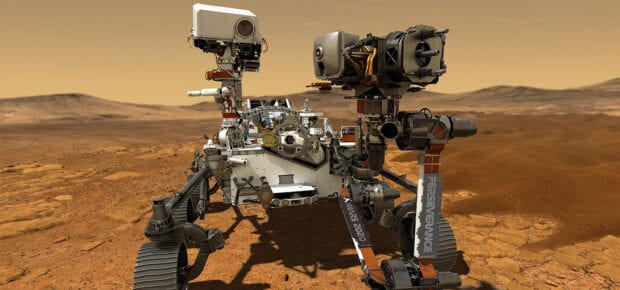




 Liquid Infrastructure: Our Planet's Most Precious Resource
Liquid Infrastructure: Our Planet's Most Precious Resource The Impact of Technology in 2025
The Impact of Technology in 2025 Quantum and AI: Safeguards or Threats to Cybersecurity?
Quantum and AI: Safeguards or Threats to Cybersecurity? Why AI Can't Live Without Us
Why AI Can't Live Without Us Bits, Bytes, Buildings and Bridges: Digital-Driven Infrastructure
Bits, Bytes, Buildings and Bridges: Digital-Driven Infrastructure Impact of Technology in 2024
Impact of Technology in 2024 Emerging AI Cybersecurity Challenges and Solutions
Emerging AI Cybersecurity Challenges and Solutions The Skies are Unlimited
The Skies are Unlimited Smart Cities 2030: How Tech is Reshaping Urbanscapes
Smart Cities 2030: How Tech is Reshaping Urbanscapes Impact of Technology 2023
Impact of Technology 2023 Cybersecurity for Life-Changing Innovations
Cybersecurity for Life-Changing Innovations Smarter Wearables Healthier Life
Smarter Wearables Healthier Life Infrastructure In Motion
Infrastructure In Motion The Impact of Tech in 2022 and Beyond
The Impact of Tech in 2022 and Beyond Cybersecurity, Technology and Protecting Our World
Cybersecurity, Technology and Protecting Our World How Technology Helps us Understand Our Health and Wellness
How Technology Helps us Understand Our Health and Wellness The Resilience of Humanity
The Resilience of Humanity Harnessing and Sustaining our Natural Resources
Harnessing and Sustaining our Natural Resources Creating Healthy Spaces Through Technology
Creating Healthy Spaces Through Technology Exceptional Infrastructure Challenges, Technology and Humanity
Exceptional Infrastructure Challenges, Technology and Humanity The Global Impact of IEEE's 802 Standards
The Global Impact of IEEE's 802 Standards Scenes of our Cyber Lives: The Security Threats and Technology Solutions Protecting Us
Scenes of our Cyber Lives: The Security Threats and Technology Solutions Protecting Us How Millennial Parents are Embracing Health and Wellness Technologies for Their Generation Alpha Kids
How Millennial Parents are Embracing Health and Wellness Technologies for Their Generation Alpha Kids Space Exploration, Technology and Our Lives
Space Exploration, Technology and Our Lives Global Innovation and the Environment
Global Innovation and the Environment How Technology, Privacy and Security are Changing Each Other (And Us)
How Technology, Privacy and Security are Changing Each Other (And Us) Find us in booth 31506, LVCC South Hall 3 and experience the Technology Moon Walk
Find us in booth 31506, LVCC South Hall 3 and experience the Technology Moon Walk Virtual and Mixed Reality
Virtual and Mixed Reality How Robots are Improving our Health
How Robots are Improving our Health IEEE Experts and the Robots They are Teaching
IEEE Experts and the Robots They are Teaching See how millennial parents around the world see AI impacting the lives of their tech-infused offspring
See how millennial parents around the world see AI impacting the lives of their tech-infused offspring Take the journey from farm to table and learn how IoT will help us reach the rising demand for food production
Take the journey from farm to table and learn how IoT will help us reach the rising demand for food production Watch technical experts discuss the latest cyber threats
Watch technical experts discuss the latest cyber threats Explore how researchers, teachers, explorers, healthcare and medical professionals use immersive technologies
Explore how researchers, teachers, explorers, healthcare and medical professionals use immersive technologies Follow the timeline to see how Generation AI will be impacted by technology
Follow the timeline to see how Generation AI will be impacted by technology Learn how your IoT data can be used by experiencing a day in a connected life
Learn how your IoT data can be used by experiencing a day in a connected life Listen to technical experts discuss the biggest security threats today
Listen to technical experts discuss the biggest security threats today See how tech has influenced and evolved with the Games
See how tech has influenced and evolved with the Games Enter our virtual home to explore the IoT (Internet of Things) technologies
Enter our virtual home to explore the IoT (Internet of Things) technologies Explore an interactive map showcasing exciting innovations in robotics
Explore an interactive map showcasing exciting innovations in robotics Interactively explore A.I. in recent Hollywood movies
Interactively explore A.I. in recent Hollywood movies Get immersed in technologies that will improve patients' lives
Get immersed in technologies that will improve patients' lives